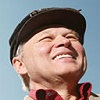9.4: Depredación
- Page ID
- 53068
Los osos capturando peces y un kookaburra emboscando a una rana (Figura\(\PageIndex{1}\), izquierda y centro) son tipos simples de depredación. Otras estrategias de emboscada también son comunes. El pez piedra (derecha) se disfraza para que coincida con su fondo y ondea un señuelo para atraer a otros peces, que luego son tragados instantáneamente enteros. A pesar de cientos de millones de años de evolución, el truco sigue funcionando.
Los gatos suelen perseguir estrategias de emboscada, al acecho (Figura\(\PageIndex{2}\), izquierda), mientras que los perros suelen perseguir estrategias sostenidas de persecución. Esto significa que los gatos deben ser relativamente inodoras para evitar ser detectados, pero los perros no necesitan serlo.
En una curiosa estrategia de emboscada recién lograda, las garzas ondean las plumas reunidas para atraer a los peces, luego dejan caer las plumas y agarran al pez (Figura\(\PageIndex{2}\), derecha). Tal uso de plumas es aparentemente un “meme” animal que se ha propagado rápidamente a través de las poblaciones de garzas después de ser descubierto por algunos Einstein-garza.
Las interacciones entre especies pueden conducir a notables adaptaciones evolutivas, incluyendo la forma no desordenada de comer un huevo (Figura\(\PageIndex{3}\) izquierda).
La naturaleza no reconoce ni amabilidad ni crueldad, pero el parasitoidismo parece una de las estrategias más crueles (Figura\(\PageIndex{3}\), derecha). Aquí una avispa Ammophilia lleva una oruga no para matar y comer, sino como criadero vivo para sus huevos. Las avispas jóvenes que se desarrollan a partir de estos huevos consumen la oruga desde adentro mientras la oruga permanece viva, transformándola en larvas de avispa. El parasitoidismo está muy extendido.
Cuando el depredador es pequeño en relación con la presa, las interacciones entre depredadores y presas se llaman “parasitismo”. A la izquierda en la Figura\(\PageIndex{4}\) se encuentra un mosquito chupador de sangre adherido a un humano desafortunado. A la derecha hay un escarabajo aparentemente abrumado por ácaros. Cuando el depredador aún es mucho más pequeño, se le llama “patógeno” y las interacciones se llaman “infección” y “enfermedad”.


